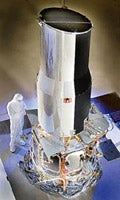Through The Looking Glass
A groundbreaking spacetelescope’and a passion for flying small airplanes’bond these NASA/JPL Spitzerteam members
 At first, it might seem a bit odd. In a control room in NASA's JPL laboratory, scientists and engineers sit, waiting for the next data stream from the world's most advanced space-imaging telescope, Spitzer. Instead of lofty conversations about the bits and bytes beaming back to Earth to decipher the mysteries of the cosmos, the conversation could likely be about airplanes. That is because a large number of these space specialists are also private pilots and they pursue their fervor for flight with as much passion as they do man's deepest exploration of the universe to date.
At first, it might seem a bit odd. In a control room in NASA's JPL laboratory, scientists and engineers sit, waiting for the next data stream from the world's most advanced space-imaging telescope, Spitzer. Instead of lofty conversations about the bits and bytes beaming back to Earth to decipher the mysteries of the cosmos, the conversation could likely be about airplanes. That is because a large number of these space specialists are also private pilots and they pursue their fervor for flight with as much passion as they do man's deepest exploration of the universe to date.
"Sometimes, if you walk down the hall, you'll hear conversations about flying, interspersed with chatter about the existence of brown dwarfs. It's amazing," laughs Booth Hartley, a Spitzer computer programmer at Caltech's Spitzer Science Center, and owner and pilot of a V-tail Bonanza. "Working for a project like Spitzer is great! But what makes it even better is that I get to work with pilots and talk about aviation."
Launched on August 25, 2003, Spitzer---NASA/JPL's Infrared Space Telescope---can observe infrared radiation or heat shrouded by cosmic dust, allowing astronomers to peer through obscured cocoons of star formations and into the hearts of dusty galaxies several billion light-years away---even those that are invisible to the Hubble Space Telescope. It's so powerful that astronomers are hoping to soon discover the origins of the universe. In fact, its mere seven months in orbit has already produced images of cosmic worlds that no one else has ever seen: a glowing stellar nursery, a swirling, dusty galaxy and organic material in the distant universe.
 "It's a time machine and probe into the distant universe, which hasn't been available until now," says Spitzer deputy project manager William Irace excitedly. The excitement in his voice is a testament to the success of 10 years of hard work, making sure that all scheduling, budgeting and production elements proceed without a glitch. Needless to say, after years of putting such a massive project together, Irace sees Spitzer as a design that's very close to his heart.
"It's a time machine and probe into the distant universe, which hasn't been available until now," says Spitzer deputy project manager William Irace excitedly. The excitement in his voice is a testament to the success of 10 years of hard work, making sure that all scheduling, budgeting and production elements proceed without a glitch. Needless to say, after years of putting such a massive project together, Irace sees Spitzer as a design that's very close to his heart.
But, you guessed it, Irace is also a pilot. At around the same time he joined the Spitzer team, he decided, partly for after-work relaxation and partly because it piqued his interest, to build his own airplane---an RV-6 that he and his family constructed in his garage from the ground up. That meant drilling holes, wiring and even writing the POH. "I thought, it'll keep me off the streets for a few years while we're building the telescope," chuckles Irace.
And just like Spitzer, the RV-6-A project took several man-hours to become a success. "What I do with my airplane and with the construction of it is a scaled-down version of what NASA and teams of us who produce things like Spitzer do on a grand scale. So my interest in being part of and leading the Spitzer team was manifested in the aviation world by my interest in building my airplane, which is a tremendous exploration, an adventure, really, for a person who has never done that," explains Irace.
The adventure, at times, took a life of its own and, at one point, seemed to be competing with the bigger-scaled Spitzer project. "This airplane is a product that grew out of the same time period when I helped design and manage Spitzer. I've always considered the telescope and the airplane project as competing for launch. So when I flew the airplane for the first time in July 2001, it meant I beat Spitzer off the ground," grins Irace.
Today, Irace calls his RV-6 an "exploratory tool" as he takes in the beautiful sights from above ground. He enthuses, "It's so spectacularly beautiful from up there that it's a constant adventure for me and an honor to be allowed to own the Southwest the way I do with my little airplane."
 Nick Gautier, fellow pilot and Spitzer astronomer, has a day job looking at Spitzer's optical and thermal aspects, making sure that the science doesn't get compromised along the way. And, like the others, he often finds himself in the company of fellow aviation lovers during office hours.
Nick Gautier, fellow pilot and Spitzer astronomer, has a day job looking at Spitzer's optical and thermal aspects, making sure that the science doesn't get compromised along the way. And, like the others, he often finds himself in the company of fellow aviation lovers during office hours.
"I once had a great conversation with a Spitzer mechanical engineer about how flight dynamics get into the regions of your flight envelope where you get reverse aileron control. He doesn't have a pilot's license, but he gets it because he's already tuned into aerospace. JPL is a great place for pilots to work, even if there weren't other pilots working here," remarks Gautier.
During his spare time, Gautier keeps company with other JPL pilots by flying via the Caltech Flying Club, which has the tradition of giving open invitations to anyone in the JPL community. And, just like Irace and Hartley, his love for astronomy runs parallel with his love for aviation---even in the cockpit.
Gautier explains, "No astronomer gets to touch his stars. He has to depend on his instruments to do that for him. That helps tune me in to the instrument interface in the airplane. Analytical thinking carries over in both directions. My enjoyment of astronomy and aviation, and the mindset that goes along with them are complementary. The kind of focusing I have to do in my flying helps me focus on some of the things I need to do with Spitzer, and the technical and analytical aspects of what I do with Spitzer help me understand things that I do while I'm flying. It's definitely the best of both worlds."

Subscribe to Our Newsletter
Get the latest Plane & Pilot Magazine stories delivered directly to your inbox






